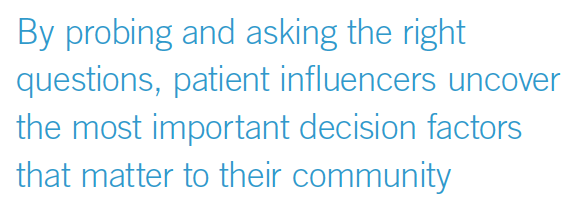- Sustainability
- DE&I
- Pandemic
- Finance
- Legal
- Technology
- Regulatory
- Global
- Pricing
- Strategy
- R&D/Clinical Trials
- Opinion
- Executive Roundtable
- Sales & Marketing
- Executive Profiles
- Leadership
- Market Access
- Patient Engagement
- Supply Chain
- Industry Trends
Patient KOLs: Their Guide to Entering Crowded Markets
Pharmaceutical Executive
How “patient influencers” look beyond price to help the industry evaluate newly-launched brands.
"Patient influencers" look beyond price to help the industry evaluate newly-launched brands
Patient influencers, also referred to as patient key opinion leaders (KOLs), often play an overlooked role in advising the patient communities they lead- combining friends-and-family trust with their own research and the experience of tens of thousands of followers. They can drive awareness by educating their communities, but patient influencers’ more critical role is guiding patients from awareness to the doctor’s office, and from an initial prescription to the decision to fill.
“People in the patient community know who they can trust, who to turn to,” says Anne-Marie Ciccarella, a leading cancer patient influencer. Ciccarella describes a many-sided conversation that speaks to patients in their own terms, and “they seek people they know they can trust to help them frame the questions, and they leave the conversation more confident about what to ask, about what to say to their doctor. That can be the difference between hearing about a drug and actually making the appointment.”
Even if that appointment results in a prescription from a credible physician, patients often refer to their trustworthy communities with questions. “After a prescription is where the questions change to cost and

insurance-along with the most common question, ‘who else is on this?’” says Ciccarella
While patient influencers try to avoid making specific recommendations-“we’re not playing doctor,” notes Ciccarella-they excel at surfacing the wisdom of the crowd. By probing and asking the right questions, patient influencers uncover the most important decision factors that matter to their community.
Patient influencers see three dominating issues resulting from thousands of hours of conversation with their communities, exploring every stage of the drug lifecycle, from as early as clinical trial design to loss of exclusivity strategies.
1. Access to empathy, pricing, and patient assistance
Patient communities have become organic support networks, sharing real-life experiences, tips, tricks, contact names, and outright hacks to help each other to pay for their medications. Patient influencers frequently act as navigators and moderators for members wrestling not just confusion, but a range of emotions. “Many cancer drugs are prohibitively expensive. ... Even when insurance companies approve specialty drugs, the co-pays alone can be financially crippling,” says Rick Davis of Answer Cancer Foundation, a WEGO Health participant/partner. “Men diagnosed with metastatic prostate cancer are frequently prescribed drugs that run $8,000 to $12,000/month, so co-pays may be as much as $3,000. Knowledgeable patient advocates can reduce patient stress at a time when the immune system is already under siege. Good advocates help navigate the system directing patients to sources of financial and emotional support.”
Nowhere are cost-of-care discussions more active than in cancer patient communities, where CAR-T drugs like Novartis’ Kymriah and Kite/Gilead’s Yescarta offer real hope-and real challenges-for patients who need to know how they’ll pay. Davis says, “In cases where expensive FDA-approved drugs are prescribed off-label, we will frequently arm the patient with clinical evidence and specific doctor referrals to pass on to the insurance companies.”
One way that patient influencers help is by learning about, and sharing, pharma companies’ patient assistance programs (PAPs). The general perception of PAPs is that they are extremely helpful for low-income patients and the uninsured. “Once Medicare, Medicaid, or commercial insurance enter the mix, it gets really complex,” notes Davis. “As advocates, even just explaining the ‘donut hole’ to Medicare patients can relieve anxiety. We cannot be an expert on every plan, so connecting patients to peers who have already fought the battle can be huge, especially when the same drug is in focus and the pharma has a PAP. Peers will share tips.”
Some tips can feel more like hacks-from skipping online forms in favor of live support, to the extreme examples of changing insurance plans or even moving to a new state to find coverage.
Universally, patient influencers feel they can help companies to design better PAPs, and they are ready to collaborate before a PAP causes confusion and even backlash. “Goundbreaking drugs invariably come with a high price that users must address,” says Davis. “A good assistance plan shows the patient that pharmas have a heart and they recognize the patient perspective.”
2. Efficacy and side effects
Every day, patient influencers and their communities discuss effectiveness of one drug versus another, and it can be a complex topic for patients who don’t know exactly what to expect from a treatment. Patient influencers field questions like, “Am I getting the benefit I should?” “Are others feeling better than this after three months?” and, “Should I expect this to keep working?”
Medication side effects run alongside efficacy, and patient communities debate them as equal factors in their decisions to request a new drug. When combined with cost, efficacy and side effects can either drive a prescription fill-or send patients back for an alternative. Patient communities have become sophisticated in their debates, especially in chronic conditions like hemophilia.
“When a new drug comes to market, questions and/or concerns about how it works and if it’s safe tend to run amok,” says Dakota Rosenfelt, a hemophilia patient influencer. “Connecting patients to others on the same drug is the tried-and-true way of giving someone peace of mind when it comes to switching or starting a new treatment option. When someone is first starting a new therapy, connecting to a patient already taking the therapy can help ease any concerns over safety or efficacy, especially in this age where novel therapies are becoming more and more common.”
For launch drugs such as Genentech’s Hemlibra for hemophilia A, that lack of shared experiences can slow uptake as patient influencers try to fill the knowledge gap. Pharma companies are often surprised to learn that patient influencers want their help, especially at launch, to provide objective clinical data and “is-this-for-you?” education.
“I use links to studies as well as videos provided by the manufacturers to help inform patients about the therapy they have in question,” says Rosenfelt. “It would be more beneficial for manufacturers to provide links to their own studies, and maybe even ones with similar focus, on the websites they develop for the therapies. Some manufactures go above and beyond to provide an educational site about the condition in general.”
Rosenfelt believes this presents a significant “gold mine for patient advocates because it gives us a cumulative central source to send in questions.” An example of this type of resource is Bayer’s livingwithhemophilia.com. The site provides comprehensive information about living with and managing hemophilia, presented in an easy-to-understand fashion.
Patient influencers often create their own content to answer frequent questions, from blog posts to podcasts to do-it-yourself (DIY) videos. Supporting this influencer-generated content is another opportunity for pharma companies to work with patient communities. “Having the support of the manufacturers to create these videos and scan them for accuracy would be huge for the patient communities we jointly serve,” says Rosenfelt. “Through the help of the company’s broad reach and distribution channels, our combined impact seen could be limitless.”
3. Lifestyle and convenience
For many patient influencers, helping their communities better understand how treatments will impact their everyday lives is an ongoing effort. Questions such as, “Will I be able to stick to the dosing schedule?” “Do I need to fight for prior authorization with each course?” “Do side effects occur when I’m trying to spend quality family time?” “Will it require a specialty pharmacy?” “Can I carry the injector in my purse?”
Almost unanimously, patient influencers feel that pharma companies and healthcare professionals (HCPs) underplay the real role of daily life in dictating even life-saving treatment decisions. “Patients and even their caregivers are savvy enough to know that even a much more convenient approach may not be a good reason to switch if their current treatment is working,” says multiple sclerosis (MS) patient influencer Wendy Booker. “But I also see patients who already feel their illness is impacting their family, or their work, and they weigh a new drug’s medical benefits against making their ‘non-sick’ life harder.”
The MS community has been a fast-moving laboratory, testing lifestyle and convenience trade-offs. After decades without many options, MS patient influencers have now become experts at facilitating their communities’ many choices. When oral medications in this disease space first launched, there was some skepticism about convenience-over-effectiveness gimmickry, but oral therapies are now well understood and accepted as powerful new options.
Today, products like Genentech’s Ocrevus are testing the limits of the lifestyle-versus-efficacy debate for patients. For many forms of MS, the drug is a true breakthrough in disease management, but because it must be administered in special infusion centers, convenience will be a critical issue. “At first, it may look like a step backwards as orals are becoming so common,” says Booker. “But Ocrevus is the first disease-modifying therapy for both primary progressive MS and relapsing-remitting MS and it remains to be seen if the community’s experience is worth the trade-offs. A lot will have to do with things like transportation and how the infusion experience is perceived.”
For pharma companies, the nuances of the patient community’s evaluation can’t be understood with only large-scale quantitative studies. An MS oral therapy launched a few years ago found this out the hard way. Surveys showed side effects were in line with competition, but the medication had a slightly higher incidence of hair

loss. While occurrences were rare, a few stories of rapid hair loss (with pictures) spread fast through the largely female MS community online, and launch expectations had to be reset.
“What companies need to do is listen to us, the patient influencers, early and often,” says Shari Berman, another influencer in MS.
True patient centricity means creating a “patient KOL” advisory group, no less important than physician KOLs. Speaking on behalf of their communities’ shared experiences, patient influencers are the real-world analysts of the patient journey. Effective groups advise companies on what questions to ask the larger community, then help to translate the findings into a new trial or an assistance program design; they separate the “me-too” from the standout patient marketing and education, and they can help brands build a scorecard that reflects how patients will evaluate their products.
“Pharma companies should know by now that we want to help them get it right,” says Berman.

Jack Barrette is CEO and Founder of WEGO Health

Transforming Cancer Care: Data, AI, and Patient-Centered Care
July 20th 2023Join us as Mohit Manrao, SVP and head of US oncology at AstraZeneca, shares his patient-centered approach to transforming cancer care, bridging the gap between innovative science and tangible patient outcomes across all populations on a global scale.
